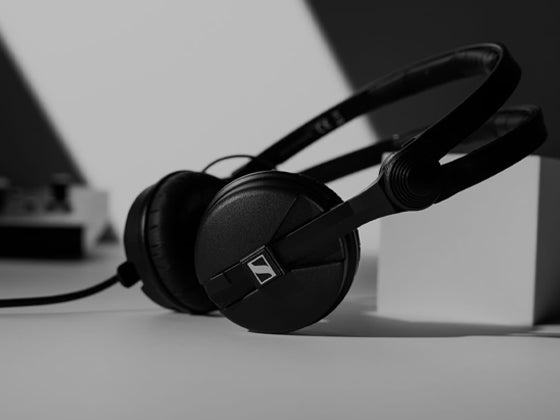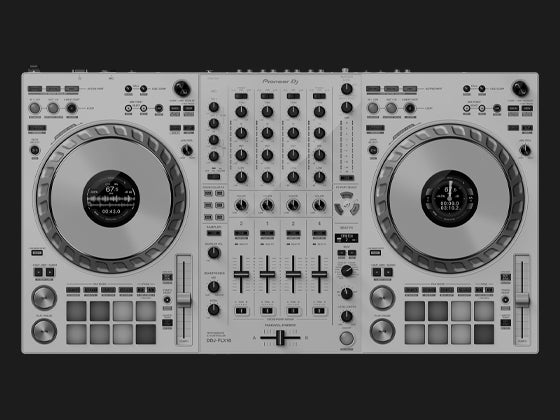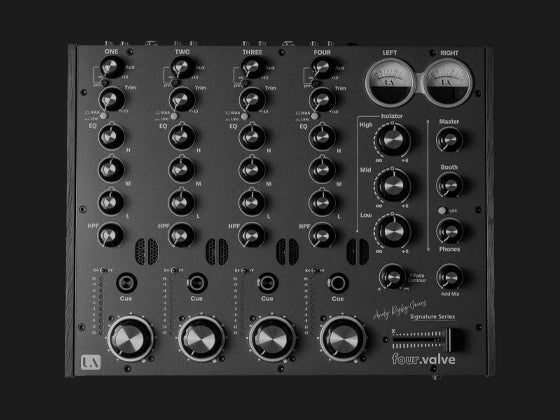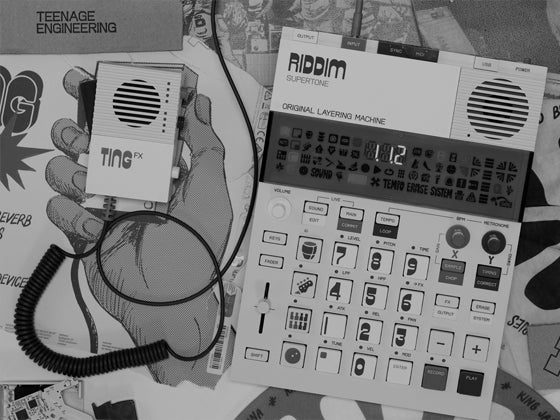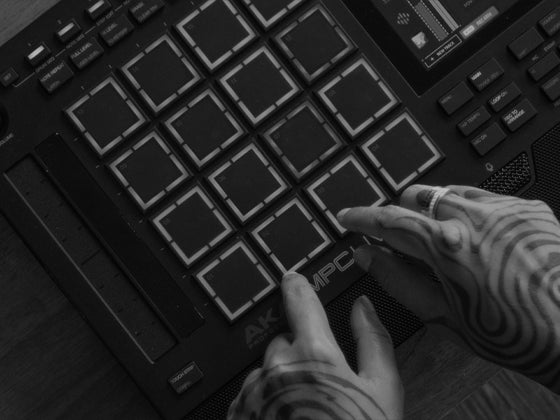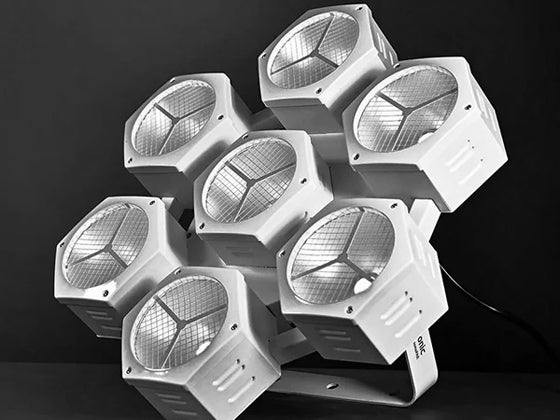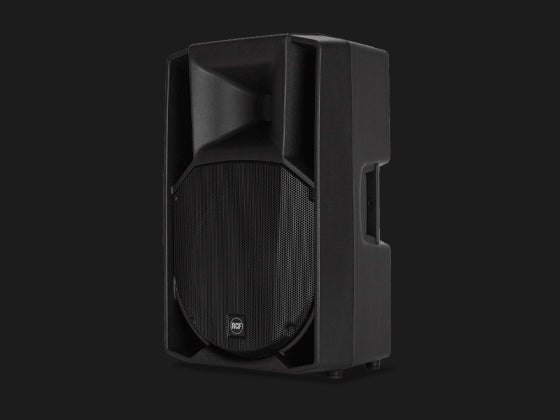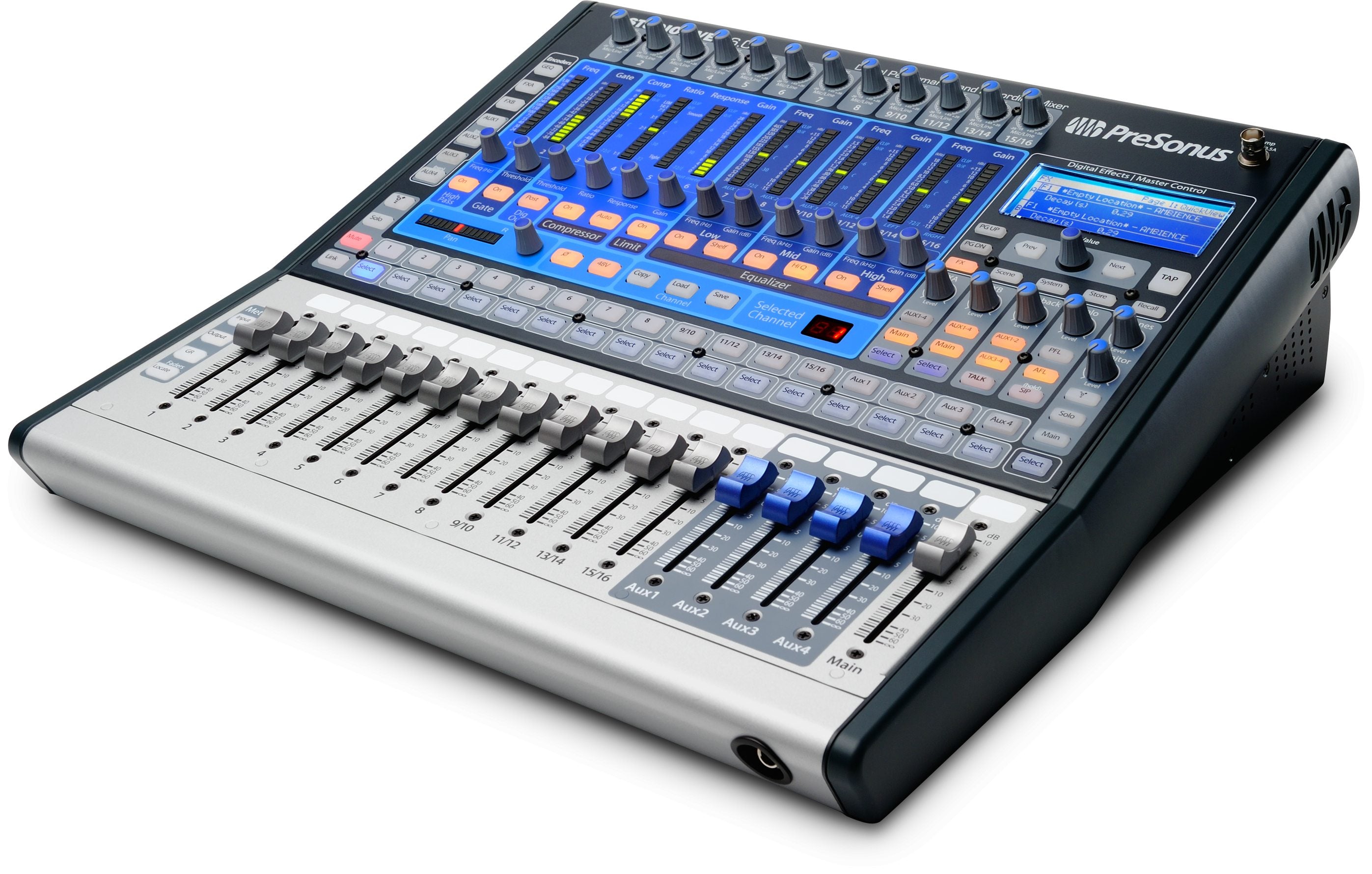
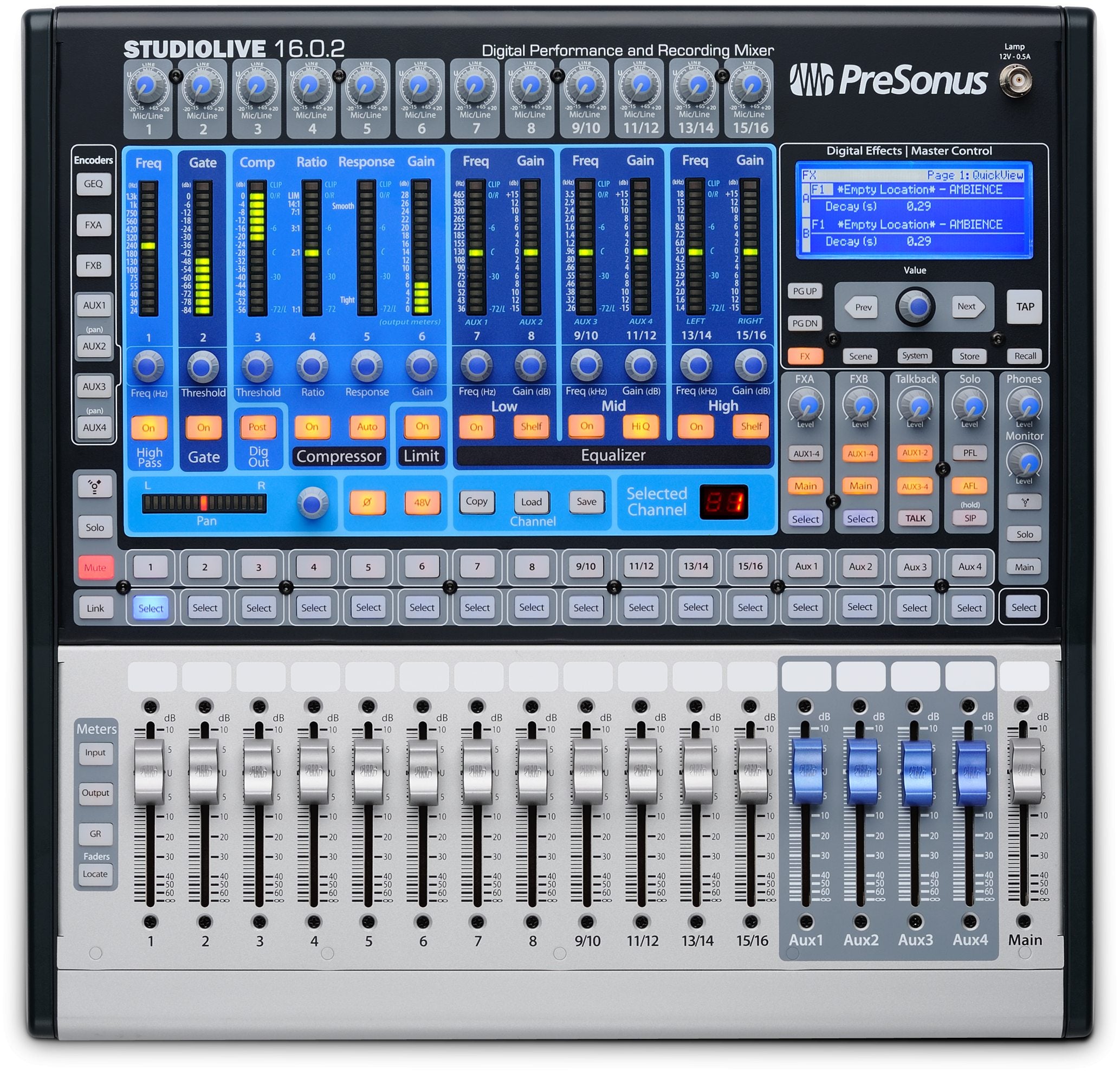
Presonus
PRESONUS StudioLive 16.0.2 - 16x2 Mixing Console
In a “footprint” of less than 2 square feet (0.19 sq. meters), the compact, 16-channel StudioLive 16.0.2 offers 8 mono input channels and 4 stereo channels and provides 12 XMAX™ Class A solid-state mic preamps. (It has a total of 13 Class A mic preamps, including the Talkback input.)
But don't let its size fool you; the 16.0.2 is jam-packed with features and processing power, employs the same workflow and easy-to-use mixing-surface design as the bigger StudioLive boards, and sounds every bit as good, with the same high-definition, wide-dynamic-range, digital converters.
The StudioLive™ 16.0.2 integrates a 16x16 FireWire interface (fully compatible with Apple's Thunderbolt™to FireWire Adapter) and comes with Capture™, Studio One Artist™ recording and production software, and Virtual StudioLive (VSL) bidirectional control software. VSL, in turn, incorporates Smaart Measurement Technology™, which makes it easy to analyze and fine-tune your main mix.
-
Computer system requirements:
Below are the minimum computer-system requirements for Virtual StudioLive.
Windows
- Windows 7x 64/x86 SP1 or Windows 8/8.1 x64/x86 or Windows 10 x64/x86
- Intel® Core™ 2 processor (Intel® Core™ i3 processor or better recommended)
- 4 GB RAM (8 GB or more recommended)
Mac
- Mac® OS X 10.6.8 or later
- Intel Core Duo processor (Intel Core 2 Duo or Core i3 or better recommended)
- 2 GB RAM (4 GB or more recommended)
Windows and Mac Systems
- PreSonus Universal Control 1.5.3 or later
- IEEE 1394 FireWire 400 Port or Thunderbolt Port and Thunderbolt to FireWire Adapter
- Internet connection recommended
- DVD-ROM drive
- Internal or external 7200 RPM storage drive highly recommended
- Monitor with 1024x768 resolution
The minimum system requirements may differ for DAWs other than Studio One. Please check the requirements for your DAW of choice with its manufacturer.
Note that the speed of your processor, amount of RAM and size and speed of your hard drive will greatly affect the overall performance of your recording system. Also, a more powerful system (faster processor with more RAM) will allow for lower latency (signal delay) than you might experience while monitoring audio or MIDI signals. Monitor resolution for both PC and Macintosh should be no lower than 1024x768 pixels.
Microphone Preamp
Type XLR Female, Balanced Frequency Response to Direct Output (at unity gain) 20 Hz-40 kHz, 0 / -0.5 dBu Frequency Response to Main Output (at unity gain) 20 Hz-20 kHz, ±0.5 dBu Input Impedance (Balanced) 1 kΩ THD to Direct Output (1 kHz at unity gain) <0.005%, +4 dBu, 20 Hz–20 kHz, unity gain, unwtd THD to Main Output (1 kHz at unity gain) 0.005%, +4 dBu, 20 Hz-20 kHz, unity gain, unwtd EIN to Direct Output +125 dB unwtd, +130 dB A-wtd S/N Ratio to Direct Output (Ref = +4 dB, 20 kHz BW, unity gain, A-wtd) -97 dB S/N Ratio to Main Output (Ref = +4 dB, 20 kHz BW, unity gain, A-wtd) -94 dB Common Mode Rejection Ratio (1 kHz at unity gain) +65 dB Gain Control Range (± 1 dB) -16 dB to +67 dB Maximum Input Level (unity gain) +16 dBu Phantom Power (± 2 VDC) +48 VDC 
Line Inputs, Balanced
Type ¼" TRS Female, balanced mono Frequency Response to Direct Outputs (at unity gain) 10 Hz-40 kHz, 0 / -0.5 dBu Frequency Response to Main Outputs (at unity gain) 20 Hz-20 kHz, 0/-0.5 dBu Input Impedance 10 kΩ THD to Direct Output (1 kHz at unity gain) <0.0007%, +4 dBu, 20 Hz-20 kHz, unity gain, unwtd THD to Main Output (1 kHz at unity gain) <0.005%, +4 dBu, 20 Hz-20 kHz, unity gain, unwtd S/N Ratio to Direct Output (Ref = +4 dBu, 20 kHz BW, unity gain, A-wtd) -105 dB S/N Ratio to Main Output (Ref = +4 dBu, 20 kHz BW, unity gain, A-wtd) -94 dB Gain Control Range (± 1 dB) -20 dB to +20 dB Maximum Input level (unity gain) +22 dBu 
Line Inputs, Unbalanced
Type RCA Female, unbalanced (stereo pair) Maximum Input Level +22 dBu 
Main Outputs
Type XLR Male, balanced (stereo pair); ¼” TRS Female, balanced (stereo pair) Rated Output Level +24 dBu Output Impedance 100Ω Aux Outputs
Type ¼” TRS Female, balanced (mono) Rated Output Level +18 dBu Output Impedance 100Ω 
Monitor Outputs
Type ¼” TRS Female, balanced (stereo pair) Rated Output Level z +18 dBu Output Impedance 100Ω 
System Crosstalk
Input to Output (Ref = +4 dBu, 20 Hz-20 kHz, unwtd) -90 dBu Adjacent Channels (Ref = +4 dBu, 20 Hz-20 kHz, unwtd) -87 dBu 
Noise Gate (Expander)
Threshold Range -84 dB to 0 dB Attack Time Adaptive (0.2 - 2.5 ms) Release Time 70 ms Expander Attenuation Range 2:1 
Compressor
Threshold Range -56 dB to 0 dB Ratio 1:1 to 14:1 Response Time (Attack/Release 0.2 ms / 1.0s (“Tight”) to 180 ms / 1.0s (“Smooth”) Auto Attack and Release Attack = 10 ms, Release = 150 ms Curve Types hard and soft knee 
EQ
Type 2nd-order shelving filter (Q = 0.55) Low (Low-pass or Bandpass) 36 to 465 Hz, ±15 dB Mid 260 Hz to 3.5 kHz, ±15 dB High (High-pass or Bandpass) 1.4 kHz to 18 kHz, ±15 dB 
Digital Audio
ADC Dynamic Range (A-wtd, 48 kHz) 118 dB DAC Dynamic Range (A-wtd, 48 kHz) 118 dB FireWire S400, 400 Mb/s Internal Processing 32-bit, floating point Sampling Rate 44.1, 48 kHz A/D/A Bit Depth 24 bits Reference Level for 0 dBFS +18 dBu 
Clock
Jitter <20 ps rms (20 Hz - 20 kHz) Jitter Attenuation >60 dB (1 ns in ≈ 1 ps out) 
Power
Connector IEC Input-Voltage Range 100 to 240 VAC (factory-configured for country of destination) Power Requirements (continuous) 100W 
Physical
Length 15.56 inches (397 mm) Width 16 inches (406 mm) Maximum Height 5.5 inches (140 mm) Weight 20 lbs. As a commitment to constant improvement, PreSonus Audio Electronics, Inc., reserves the right to change any specification stated herein, at any time, without notification.
- 8 mono mic/line channel inputs & 4 stereo line channel inputs
- High-headroom Class A XMAX mic preamplifier
- XLR mic and balanced ¼" line inputs
- 16-in/16-out FireWire recording interface (24-bit/44.1 kHz and 48 kHz)
- Scene store and recall
- Free StudioLive Remote iPad® wireless-control software (from app store)

